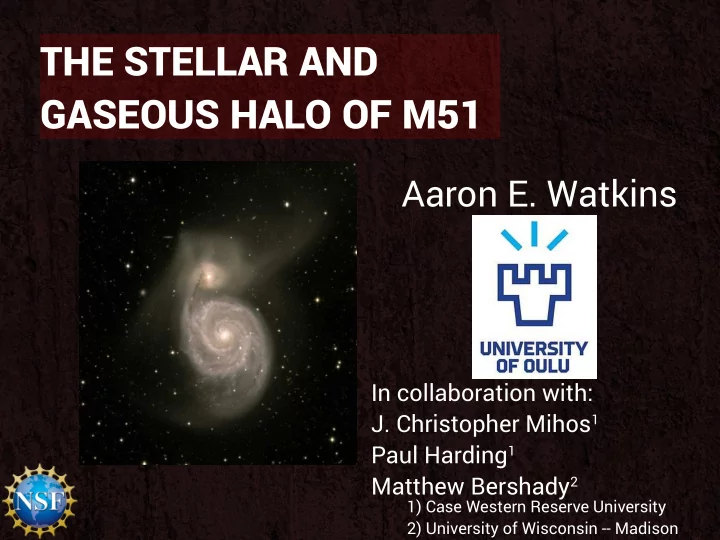

THE STELLAR AND GASEOUS HALO OF M51 Aaron E. Watkins In collaboration with: J. Christopher Mihos 1 Paul Harding 1 Matthew Bershady 2 1) Case Western Reserve University 2) University of Wisconsin -- Madison
INTRODUCTION TO M51 ● Historically important galaxy pair -- spirals, interactions, gas M51b tidal response, &c. ● Nearby: D ~ 8.5 Mpc ● About the system: M51a – Disk mass ratio ~1/3 -- 1/2 (e.g., Smith et al. 1990, Salo & Laurikainen 2000, &c.) – Gas-rich Sc disk (M51a) + gas- poor SAB disk (M51b) Hubble Heritage Archive
OBSERVATIONS ● Burrell Schmidt Telescope (recall Chris Mihos' talk) ● Full mosaic ~2°x2° (focal plane f.o.v. This one ~1.5°x1.5°) ● Exposure times: 31x1200s (B), 39 x 900s (V) ● μ limit ~ 30 mag/arcsec 2 (B)
RESULTS ● East/West 10´ (~25 kpc) Streams: - B-V~0.75 (same as M51b) - coherent (disk origin), caustic? - μ~25.5--26 - L ⊙ ~ 4x10 7 , B (each) Watkins + 2015
RESULTS ● Northwest Plume: 10´ (~25 kpc) - B-V~0.8 (color of outer disks; Watkins+14, 16) - Still coherent despite length (~30 kpc end to end) - μ~27.5--28 - L ⊙ ~ 10 8 , B Watkins + 2015
RESULTS ● Northeast Plume: 10´ (~25 kpc) - μ~29, no good color constraint - Related to 'crown'? ● South Plume - μ~29 - Accreted? ● Both L ⊙ ~ 5x10 6 , B Watkins + 2015
HALO GAS CONTENT ● System surrounded by tidally stripped gas ● No obvious stellar counterpart to any extended HI ● 2015: follow-up deep narrowband imaging with Burrell Schmidt ● Interesting discovery...! 21 cm observations from Rots + 1990
Hα NARROWBAND IMAGE Watkins + 2018
Hα NARROWBAND IMAGE 32 kpc Watkins + 2018
SPARSEPAK SPECTRUM V hel ~ 640 km/s V M51 ~460 km/s Watkins + 2018
LINE RATIOS ● log(NII / Hα) ~ +0.17 ● log(SII / Hα) ~ -0.10 ● log(OI / Hα) ~ -0.77 BPT Diagrams from: Singh + 2013
FATE OF GAS IN MERGERS ● M51, ionization only IC 2497 ● "Hanny's Voorwerp": similar origin object (?), but embedded HII regions! ● In some AGN hosts, halo stars might form literally "in-situ" Green = OIII 5007 Orange = Hα+NII
SUMMARY ● In the M51 system, the "stellar halo" observed with deep imaging appears mainly to originate with both galaxies' disks ● Gaseous tidal debris is also abundant, and energetic phenomenon (AGN? shocks?) ionized a swath of it ● Energetic winds/shocks: how often can this energy injection form literally "in-situ" halo stars?
Recommend
More recommend